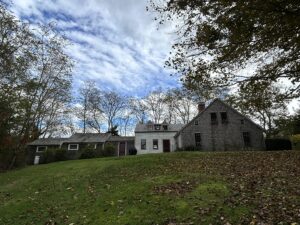WELLFLEET — Matthew Walker and Sally McCarthy, who live in Washington, D.C., have applied for a permit to demolish the Capt. Joseph Hatch House, a full Cape built around 1780. The owners of the 240-year-old house at 90 Coles Neck Road say they have explored every option available to preserve this piece of local history but have concluded it is just not possible to do so.

The age of the house triggered a review by the Wellfleet Historical Commission under the town’s demolition delay bylaw, which can stall the demolition of a structure 75 years old or older for up to 18 months if it would destroy its significance to the historical, cultural, or architectural heritage of the town. The delay would allow time to explore alternatives.
During its Oct. 9 hearing, the commission took the first step in the review process, unanimously agreeing that the house was historically significant. The next step will be a formal hearing on the proposed demolition, which the commission will schedule for early November.
At the meeting, commission co-chair Merrill Mead-Fox said the house had belonged to members of the Cole, Hatch, and Freeman families, who were all prominent among Wellfleet’s early inhabitants. “Charles Freeman, who owned the house in the 1880s, is listed on the town census as a mariner and master mariner, and we know that’s very much part of the cultural history of this town,” she said.
Matthew Walker told the commission the house has been in his family for 86 years, spanning three generations. Other members of his family live nearby at 70 Coles Neck, he said, and the tract separating their two houses is conservation land named after his grandparents, Charles and Adelaide Walker. “We’re deeply attached to this corner of Wellfleet,” he said. “We don’t take the decision to remove the old house lightly.”
Walker said that although the town’s historical survey indicates the house sits on a brick foundation, there is essentially no foundation there. “It rests on 300-year-old tree trunks and an assortment of bricks and two-by-fours that have more recently been used to shore up the house as it shifts and slopes more and more,” he said. Walker provided an inspection report that concluded the house was infested with powder post beetles, leaving its beams and studs unstable.
“We invested in architectural designs that aimed to preserve the original house while replacing the 20th century additions,” Walker and McCarthy wrote in a letter to the commission. The couple decided that plan would be too expensive.
“Our family does not have the resources to restore this precarious, structurally unsound house,” they wrote.
“We’ll salvage every nonstructural item we can,” Walker told the commissioners. The couple was also willing to give the old house free of charge to anyone willing to remove it from the property.

Walker said he and McCarthy have already spent three years considering alternatives to demolition. “There’s no point from our perspective in further delay,” he said. “Delay will only guarantee our costs will continue to climb.”
The couple has already hired Orleans builder Craig Sweeney to build a new single-gabled house on the site.
Commissioner Kevin Sheehan, who has a background in historic restoration, pointed out that houses dating back to the 1700s were constructed in a way that allowed them to be taken apart in sections and put back together. “The main house is only 750 square feet as a footprint,” Sheehan said. “Sills can be replaced, and posts can be replaced.”
Commission member Stephen Douglass said he had expected to see a dilapidated structure during a recent site visit. Instead, he said, “The walls are still plumb; there’s a bit of a sag at the ridge line but not bad at all.” The inspection report Walker submitted had been done by a pest control inspector, not an engineer, Douglass said.
Walker conceded that conclusions that the house was structurally unsound were based on the opinions of builders, excavators, and movers, not engineers.
While the commission can’t require an applicant to do an engineering study, co-chair Timothy Curley-Egan urged Walker to hire a structural engineer. “I think it’s difficult making statements that it’s structurally unsound without a structural engineer looking at it,” he said.
“Saving that structure is our number-one priority,” Curley-Egan said. Even if the homeowners plan to move ahead with replacing the old house, any proposal to move it to another property would require a structural engineer looking at it, he added.
What if a structural engineer comes back and says it can be restored for millions of dollars, McCarthy asked. Sheehan called that “a gray area” but said it is addressed in the demolition delay bylaw.
Mead-Fox, whose 19th-century house underwent a major restoration under a previous owner, said the cost of restoration would not be millions of dollars based on the purchase price of her house, which is larger than the house on Coles Neck.
“I know it is possible to do this, and it can be done, not at an enormous expense, especially with a smaller footprint,” she said.
The demolition delay hearing will likely be held sometime in the first two weeks of November, Mead-Fox said.



